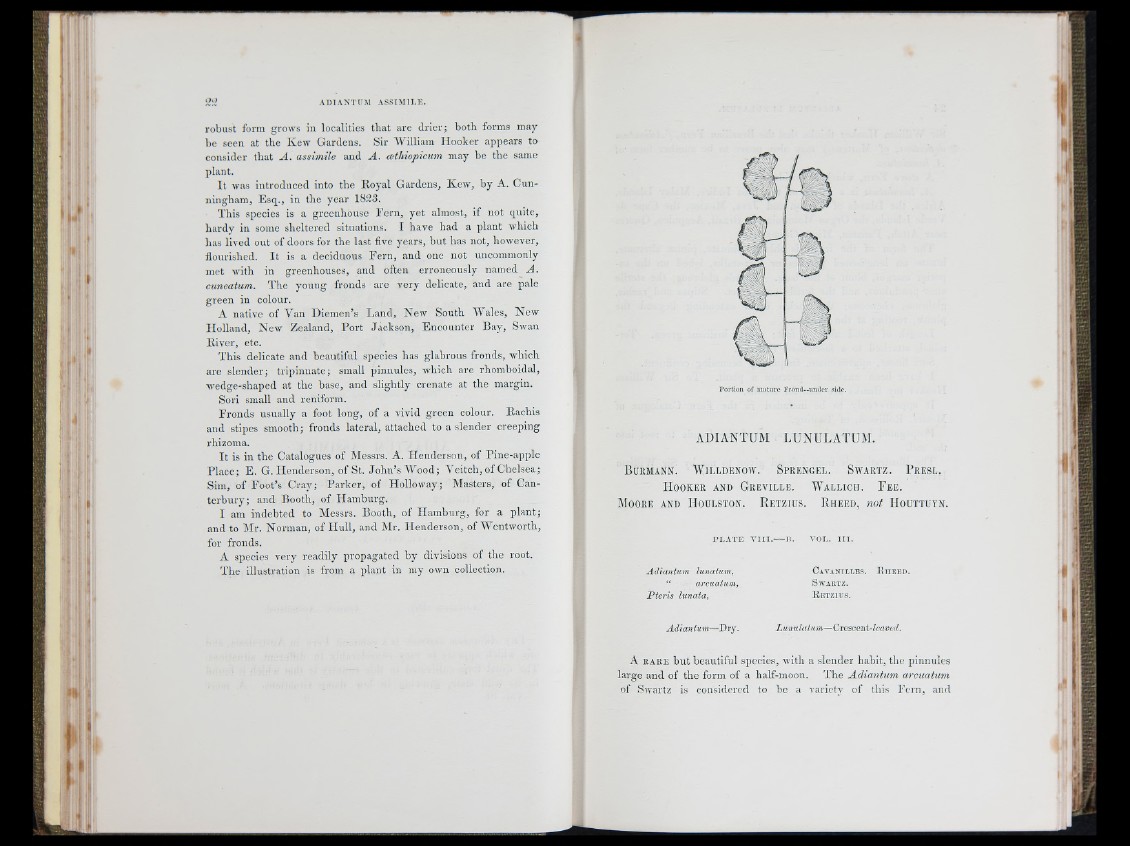
l ! ‘
' I )
»«* i
robust form grows in localities th a t are d rie r; b o th forms may
be seen at the Kew Gardens. Sir William Ho o k e r appears to
consider th a t A . assimile and A . cetMopicum may he the same
plant.
I t was introduc ed into the Royal Gardens, Kew, b y A. Cu n n
ingham, E sq ., in the ye a r 18il3.
This species is a greenhouse F e rn , y e t almost, if n o t q u ite ,
h a rd y in some she lte red situations. I have h ad a plan t wdiich
has lived out of doors for the last five years, b u t has not, however,
fiourishcd. I t is a deciduous F e rn , and one not uncommonly
met Avith in greenhouses, and often erroneously named A .
cuneatum. TTie young fronds are very delicate, and are pale
g re en in colour.
A native of Van Diemen’s L an d , New South Wales, New
H o llan d , New Zealand, P o rt Ja ckson, E n co u n te r Bay, Swan
RiA'cr, etc.
This delicate and beautiful species has glabrous fronds, Avhich
are slen d e r; trip in n a te ; small pinnules, which are rhomboidal,
Avedge-shaped at the base, and slightly crenate at th e margin.
Sori small and reniform.
Fro n d s usua lly a foot long, of a vivid green colour. Rachis
and stipes smooth; fronds lateral, attached to a slender creeping
rhizoma.
I t is in the Catalogues of Messrs. A. H en d e rso n , of Pine-apple
P la c e ; E . G. H en derson, of St. J o h n ’s AVood; V e itch , of C helsea;
Sim, of F o o t’s C ray ; P a rk e r, of H olloway; Masters, of Cante
rb u ry ; and Booth, of Hamb u rg .
I am in d eb ted to Messrs. Booth, of H am b u rg , for a p la n t;
and to Mr. Norman, of H u ll, and Mr. H en d e rso n , of MYntworth,
for fronds.
A species A - e r y readily propagated b y divisions of the root.
T h e illustration is from a plant in my own collection.
Portion of miitui’c Frond—under side.
ADIANTUM LUNULATUM.
B u rm a n n . W il ld en o a v . S p r e n g e l . S w a r t z . P r e s l .
H o o k e r a n d G r e v i l l e . W a l l i c i i . P"e e .
M o o r e a n d H o u l s t o n . R e t z i u s . R u e e d , not H o u t t u y n .
PLATE VIII. K. VOL. III.
A d ia n tum lunatum,
“ arcuaiiim,
P te r is lunata,
Adiantum—D ry.
CJlVANILLES. .U i ik e d .
Swartz.
K e t z iu s .
L u m d a iu m — CvG^eeiii-lcaved.
I i ‘
>
A ii.AKE h u t beautiful species, Avith a slender h abit, the pinnules
large and of the form of a half-moon. T h e A d ia n tum arcuatum
of SAvartz is considered to be a variety of this F e rn , and